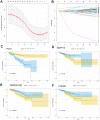Immune-related biomarker risk score predicts prognosis in prostate cancer
- PMID: 33197890
- PMCID: PMC7746334
- DOI: 10.18632/aging.103921
Immune-related biomarker risk score predicts prognosis in prostate cancer
Abstract
In this study, we constructed a model using a Cox proportional hazards model based on the expression of eight immune-related genes that were associated with prognosis in prostate cancer: EDNRB, ANGPTL2, TNFSF15, TNFRSF10D, EDN2, BMP2, NLRP14, and PLK1. We then identified associations between risk scores calculated with the model, tumor microenvironment characteristics, and immune cell infiltration. Prostate cancer patients in the high score group had poorer prognoses, and validation with the external GSE54460 dataset confirmed that the scoring model predicted biochemical recurrence with AUC values of 0.749 at 1 year, 0.804 at 3 years, and 0.774 at 5 years. Proportions of infiltrated M2 macrophages and regulatory T cells were increased in the high risk group, while CD8+ T cells were increased in the low risk group. Network analysis revealed that PLK1 may be a key regulator of the immune-suppressive microenvironment in prostate cancer. Double immunofluorescence labeling of a prostate cancer tissue microarray indicated that PLK1 expression correlated positively with numbers of infiltrating macrophages. These results indicate that an immune- related, gene-based risk score effectively reflects immune microenvironment characteristics and predicts prognosis in prostate cancer.
Keywords: PLK1; immune microenvironment; immune-related genes; prostate cancer.
Conflict of interest statement
Figures










Similar articles
-
Exploration of gene expression profiles and immune microenvironment between high and low tumor mutation burden groups in prostate cancer.Int Immunopharmacol. 2020 Sep;86:106709. doi: 10.1016/j.intimp.2020.106709. Epub 2020 Jun 24. Int Immunopharmacol. 2020. PMID: 32593155
-
Network models of prostate cancer immune microenvironments identify ROMO1 as heterogeneity and prognostic marker.Sci Rep. 2022 Jan 7;12(1):192. doi: 10.1038/s41598-021-03946-w. Sci Rep. 2022. PMID: 34996995 Free PMC article.
-
Immune response drives outcomes in prostate cancer: implications for immunotherapy.Mol Oncol. 2021 May;15(5):1358-1375. doi: 10.1002/1878-0261.12887. Epub 2020 Dec 29. Mol Oncol. 2021. PMID: 33338321 Free PMC article.
-
Immune mediators in the tumor microenvironment of prostate cancer.Chin J Cancer. 2017 Mar 14;36(1):29. doi: 10.1186/s40880-017-0198-3. Chin J Cancer. 2017. PMID: 28292326 Free PMC article. Review.
-
PITX2 methylation: a novel and effective biomarker for monitoring biochemical recurrence risk of prostate cancer.Medicine (Baltimore). 2019 Jan;98(1):e13820. doi: 10.1097/MD.0000000000013820. Medicine (Baltimore). 2019. PMID: 30608394 Free PMC article.
Cited by
-
Screening to Identify an Immune Landscape-Based Prognostic Predictor and Therapeutic Target for Prostate Cancer.Front Oncol. 2021 Nov 5;11:761643. doi: 10.3389/fonc.2021.761643. eCollection 2021. Front Oncol. 2021. PMID: 34804963 Free PMC article.
-
Lemur Tyrosine Kinases and Prostate Cancer: A Literature Review.Int J Mol Sci. 2021 May 21;22(11):5453. doi: 10.3390/ijms22115453. Int J Mol Sci. 2021. PMID: 34064250 Free PMC article. Review.
-
Blood-Derived Biomarkers of Diagnosis, Prognosis and Therapy Response in Prostate Cancer Patients.J Pers Med. 2021 Apr 13;11(4):296. doi: 10.3390/jpm11040296. J Pers Med. 2021. PMID: 33924671 Free PMC article. Review.
-
Prostate Cancer: Genetics, Epigenetics and the Need for Immunological Biomarkers.Int J Mol Sci. 2023 Aug 14;24(16):12797. doi: 10.3390/ijms241612797. Int J Mol Sci. 2023. PMID: 37628978 Free PMC article. Review.
-
Relationship between EZH2 expression and prognosis of patients with hepatocellular carcinoma using a pathomics predictive model.Heliyon. 2024 Sep 28;10(20):e38562. doi: 10.1016/j.heliyon.2024.e38562. eCollection 2024 Oct 30. Heliyon. 2024. PMID: 39640777 Free PMC article.
References
-
- Antonarakis ES, Piulats JM, Gross-Goupil M, Goh J, Ojamaa K, Hoimes CJ, Vaishampayan U, Berger R, Sezer A, Alanko T, de Wit R, Li C, Omlin A, et al.. Pembrolizumab for treatment-refractory metastatic castration-resistant prostate cancer: multicohort, open-label phase II KEYNOTE-199 study. J Clin Oncol. 2020; 38:395–405. 10.1200/JCO.19.01638 - DOI - PMC - PubMed
-
- Gao J, Ward JF, Pettaway CA, Shi LZ, Subudhi SK, Vence LM, Zhao H, Chen J, Chen H, Efstathiou E, Troncoso P, Allison JP, Logothetis CJ, et al.. VISTA is an inhibitory immune checkpoint that is increased after ipilimumab therapy in patients with prostate cancer. Nat Med. 2017; 23:551–55. 10.1038/nm.4308 - DOI - PMC - PubMed
Publication types
MeSH terms
Substances
LinkOut - more resources
Full Text Sources
Medical
Research Materials
Miscellaneous

